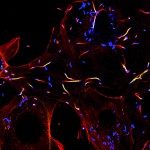Lien vers Pubmed [PMID] – 23150715
J. Immunol. 2012 Dec;189(12):5513-7
mAb therapy for experimental metastatic melanoma relies on activating receptors for the Fc portion of IgG (FcγR). Opposing results on the respective contribution of mouse FcγRI, FcγRIII, and FcγRIV have been reported using the gp75-expressing B16 melanoma and the protective anti-gp75 mAb TA99. We analyzed the contribution of FcγRs to this therapy model using bioluminescent measurement of lung metastases loads, novel mouse strains, and anti-FcγR blocking mAbs. We found that the TA99 mAb-mediated effects in a combination therapy using cyclophosphamide relied on activating FcγRs. The combination therapy, however, was not more efficient than mAb therapy alone. We demonstrate that FcγRI and, unexpectedly, FcγRIII contributed to TA99 mAb therapeutic effects, whereas FcγRIV did not. Therefore, FcγRIII and FcγRI are, together, responsible for anti-gp75 mAb therapy of B16 lung metastases. Our finding that mouse FcγRIII contributes to Ab-induced tumor reduction correlates with clinical data on its human functional equivalent human FcγRIIIA (CD16A).
